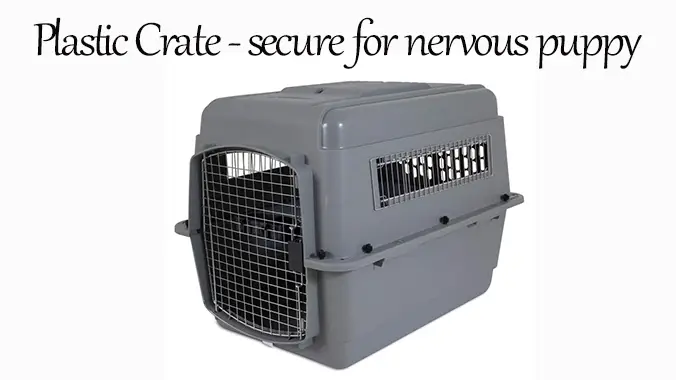I brought my new puppy home today as a family member. But when it’s nighttime, the puppy cries all night and refuses to sleep in his crate. I’m not the only one who has faced this struggle; many new dog parents are facing similar struggles during the first few nights.
Don’t worry. Here’s some good news for you. You can learn how to crate train a puppy fast at night without crying at home using gentle, proven methods. By following these simple steps, your puppy will feel safe, comfortable, and ready to sleep in his crate.
What Is Crate Training and So Important at Night
First of all, it’s essential to understand that crate training doesn’t confine your dog; it teaches the dog to view the crate as a safe, comfortable space (like a personal bedroom).
Being away from their mother and littermates and being in a new environment, your puppy is likely feeling scared and lonely, which is why they will cry and refuse to stay in the crate for the first few nights.
Kennel training is not a punishment but a positive training tool for the following:
Potty training: Puppies don’t like to soil where they sleep, so crates help them learn bladder control and prevent anxiety
Safety: Keeps your puppy safe from household hazards when you’re asleep or not home.
Routine: Helps your puppy settle down and learn in a structured environment.
Step 1: Choose the Right Crate Size and Type
Before you start, choose the perfect crate where your puppy can easily get up, turn around, and sleep comfortably. However, the size of the crate should not be too large because when it gets bigger, your puppy will pee in one corner and sleep in another.
There are mainly three types of crates:
Wire crate: Great for ventilation and visibility.

Plastic crate: Feels more enclosed and secure for

Soft crate: Good for travel once your puppy is trained.

💡Tip: Keep the crate as close to you as possible for the first few nights. Your presence comforts the puppy, and you can use a blanket or crate mat to make your puppy more comfortable.
Step 2: Create Positive Crate Associations and mindsets for crate training
Crate training should be done during the day, not at bedtime. The crate should be placed in a quiet, family-friendly area like the living room.
Keep the crate door open. When your puppy is calm after playing, take the puppy into the crate. This will help the puppy learn that this is a place to relax. Experts say that the more you associate the crate with a relaxed mindset, the more likely your puppy will be to stay in it.
Step 3: Set Up a Calm Bedtime Routine
The key to the success of any speed training is consistency.
Just like people have a daily schedule, your puppies also need a schedule to get them fully accustomed to their daily routine.
Create the following schedules to help them sleep peacefully.
- Take your puppy outside for a final potty break.
- Spend 10–15 minutes on gentle play or cuddles to burn off extra energy.
- Bring them calmly to the crate, using a command like “Bedtime” or “Crate time.”
- Give a treat or chew toy (like a puppy-safe bone) before closing the door.
💡 Tip: Our goal is to make bedtime peaceful, so dim the lights in the room but avoid talking or making too much noise.
Step 4: Keep the Crate Close at Night
To prevent your puppy from feeling lonely, place the puppy’s kennel near your bedroom or bed for the first few days.
This will help your puppy feel less lonely as he can hear and smell you.
If they cry or whine a little, say “Shh, it’s okay” in a calm voice – but don’t take them out unless you think they need to go potty.
💡 Tip: Gradually, over a few days, once your puppy starts sleeping comfortably without crying, you can move the crate farther away.
Step 5: Limit Food and Water Before Bedtime
To avoid nighttime accidents, stop food and water about 2 hours before bed. Always give your puppy one last potty trip before crating. Puppies can usually hold their bladder for about:
- 2 hours at 8 weeks
- 3–4 hours at 12 weeks
- 6+ hours at 16 weeks or older
💡 Tip: Set an alarm for one potty break in the middle of the night for very young puppies.
Step 6: Reward Calm Behavior Every Time
Use positive reinforcement of behavior, such as praise and affection, with your puppy. For example, reward your puppy when the puppy enters the crate and stays calmly.
This will help your puppy learn over time that if he stays quiet in the crate, you will bring him treats.

Step 7: Be Patient and Consistent
Even with how best methods you try, not all puppies will see the same results at the same time. Some puppies may take two to three days, while others may take a week or two. So be patient and consistent, maintaining the same bedtime, same crate location, and the same calm routine.
Remember:
👉 Puppies are learning, not misbehaving.
👉 Your calm energy teaches them to relax.
👉 A few patient nights now mean peaceful months ahead.
Step 8: Gradually Increase Crate Time
Once your puppy can sleep quietly at night, you can practice putting him in the crate for short periods of time during the day, such as while you are cooking or doing work nearby.
Increase the crate times slowly: 10 minutes → 30 minutes → 1 hour → 2 hours.
This helps your puppy become fully crate-trained — happy to rest anytime, day or night.
Step 7: Avoid These Common Mistakes while crate training
Pet lovers are always thinking about how to crate train a puppy fast at night without crying, but many pet owners make crate training too difficult and make various mistakes. What are some of the mistakes we should avoid?
- Using the crate as punishment.
→ Your puppy will associate it with fear, not safety. - Letting the puppy cry for too long.
→ It teaches them that crying is the only way to get their attention. - Leaving the puppy in the crate for too long.
→ Puppies need play, potty breaks, and interaction. - Skipping daytime crate training.
→ Practice short daytime sessions so nighttime feels normal. - Moving too fast.
→ Gradual progress builds trust and confidence.
The Path to Peaceful Sleep Starts Tonight
Crate training doesn’t have to be stressful or filled with sleepless nights.
By following these calm, consistent steps, you can learn how to crate train a puppy fast at night without crying — and help your little one feel safe and loved. Remember to keep the crate positive, follow a bedtime routine, and stay patient during the process. Within just a few nights, your puppy will begin to sleep peacefully and even enjoy their cozy crate.
Every bit of effort you put in now builds trust, good habits, and a stronger bond with your furry best friend. Peaceful nights are just around the corner!




